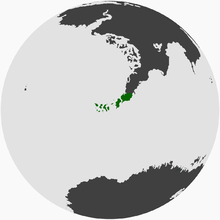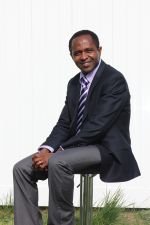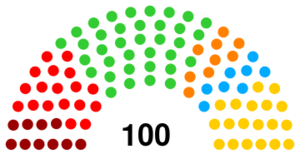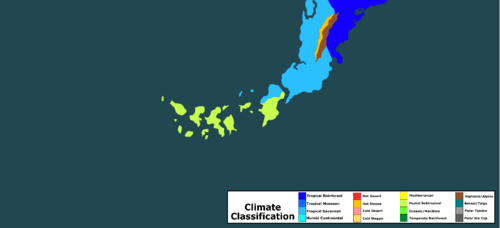Difference between revisions of "Nation/Llorens"
m |
m |
||
| (12 intermediate revisions by the same user not shown) | |||
| Line 1: | Line 1: | ||
| − | |||
| − | |||
| − | |||
| − | |||
{{Infobox country | {{Infobox country | ||
| − | |native_name | + | |native_name = Red and Gold Republic of Llorens |
| − | |image_flag | + | |image_flag = Llorens-flag.png |
| − | |image_coat | + | |image_coat = Llorens-coatofarms.png |
| − | |national_motto | + | |national_motto = We, the people of equality! |
| − | | | + | |image_map = Llorens map.png |
| − | | | + | |map_caption = The location of Llorens on the Lupamig continent |
| − | |capital | + | |capital = Zexaro |
| − | |largest_city | + | |largest_city = Zexaro |
| − | |official_languages | + | |official_languages = Llorenian, Krao |
| − | |demonym | + | |demonym = Llorenian |
| − | |government_type | + | |government_type = Federal republic |
| − | |leader_title1 | + | |leader_title1 = President |
| − | |leader_name1 | + | |leader_name1 = Justine Vartu |
| − | |leader_title2 | + | |leader_title2 = Vice-President |
| − | |leader_name2 | + | |leader_name2 = Giorgio Rentanti |
| − | |sovereignty_type | + | |sovereignty_type = History |
| − | |established_event1 | + | |established_event1 = Ancient settlement |
| − | |established_date1 | + | |established_date1 = c. 600s-1200s |
| − | |established_event2 | + | |established_event2 = Modern settlement |
| − | |established_date2 | + | |established_date2 = 6 May 1816 |
| − | |established_event3 | + | |established_event3 = Federation |
| − | |established_date3 | + | |established_date3 = 6 May 2016 |
| − | |area_km2 | + | |area_km2 = 2,574,116 |
| − | |area_sq_mi | + | |area_sq_mi = 993,872 |
| − | |population_estimate | + | |population_estimate = 32.604 million |
| − | |population_estimate_year | + | |population_estimate_year = 2020 |
| − | |population_density_km2 | + | |population_density_km2 = 12.67 |
| − | |GDP_PPP | + | |GDP_PPP = $1.965 trillion |
| − | |GDP_PPP_year | + | |GDP_PPP_year = 2019 |
| − | |GDP_PPP_per_capita | + | |GDP_PPP_per_capita = $60,284 |
| − | |HDI | + | |HDI = 0.956 |
| − | |HDI_year | + | |HDI_year = 2020 |
| − | |Gini | + | |Gini = 0.213 |
| − | |Gini_year | + | |Gini_year = 2020 |
| − | |currency | + | |currency = llorenç |
| − | |cctld | + | |cctld = .tla |
| − | + | |region = The Leftist Assembly | |
| − | |region | + | |legislature = [[Parliament of Llorens|Parliament]] |
| − | |legislature | + | |drives_on = left |
| − | |drives_on | + | |iso3166code = LLO |
| − | |iso3166code | + | |
}} | }} | ||
| − | '''Llorens''', formally the | + | '''Llorens''', formally the Red and Gold Republic of Llorens, is a federal republic situated in [[Region/The Leftist Assembly|The Leftist Assembly]]. It is on the southern end of the Lupamig continent, comprising a mainland continental area and a 16-island archipelago. The nation was formed in 2016 as a federation of its seven modern states - Ytelia, Xeñana, Ceybisa, Notonfigo, Zana, Vusmein, and Rinture - with its capital situated in Zexaro. |
| + | |||
| + | Historians believe the nation was initially settled by humans in the 600s, which suddenly disappeared in the 1200s. In modern times, it was resettled in 1816 by Vicesciasian migrants, who fled civil unrest in Greylyn during the War of 1816. | ||
| + | |||
| + | The national animal is the loquito and the currency is the llorenç (LLC). | ||
==History== | ==History== | ||
| + | ===Ancient settlement=== | ||
| + | Llorens is believed by historians to have been originally settled by humans in the 600s with migrants from central Lupamig having travelled south from the desert climate to the more accommodating temperate conditions of the southern end of the continent. These early settlers lived in hunter-gatherer tribes in southern Lupamig and the Llorenian archipelago. They were generally peaceful groups with little to no evidence of widespread conflict, and they primarily hunted fish in the waters between and surrounding the islands. Evidence of their existence has been slowly unearthed since the 1880s, notably including the discovery of the Ancient City of Gapulim by Dana Zilberschlag in 1902. | ||
| − | + | These communities appeared mostly untouched until the 1200s, at which point all evidence of their existence is erased from the historical record. Historians do not agree on the exact reason or circumstances in which this happened. One prominent theory known as the Great Escape claims that migrants from the distant Varselen continent to the south encountered them, and the militarily inferior native people escaped from the continent to the sea, effectively deserting the continent as the Varselen migrants returned home. Another theory known as the Cyclonic Extinction suggests that the peninsula was ravaged by a once-in-a-millennium cyclone that left no survivors. | |
| − | + | ||
| − | === | + | ===Modern settlement=== |
| − | The | + | The War of 1816 was the very first instance of large-scale civil unrest in Greylyn, emerging from the increasing anger of citizens with the elite Governors and class of nobility. The destruction of a Governor statue by Gertrude Orleans after the raising of taxes triggered the war, which eventually took the form of guerrilla warfare. A small group of citizens from the major coastal city of Vicesciasia, which was the centre of the conflict, fled the nation by sea through the Scarlet Gulf. |
| − | + | After three months at sea, the migrants from Greylyn arrived on the east coast of the island of Vusmein on 6 May 1816, which would eventually become a major regional centre and the modern national capital of Zexaro. The 16-island archipelago and mainland area of Rinture were gradually settled during the following decades, with it emerging under a city-state model of governance centred around the seven major cities of Liteya, Xeñana City, Valstana, Niemvusen, Zanaville, Zexaro, and Porterano. These each informally controlled their own islands and maintained friendly relations. | |
| − | + | ||
| − | + | ===Federation=== | |
| − | + | With their common heritage, geography, and language (except for the citizens of Zanaville who had since developed their own distinct dialect known as Krao), the leaders of the seven major city-states recognised the benefit in establishing a united, federal republic that could serve their collective interests and improve their geopolitical power within the region. | |
| − | + | ||
| − | + | After a series of conventions and referendums between September 2015 and April 2016, the leaders of all seven city-states ratified the Constitution of the Red and Gold Republic of Llorens, formally establishing a unified government while allowing for state authorities to maintain control of their respective regions. The Constitution created a three-branch system of government, with a 100-seat unicameral legislature known as the [[Parliament of Llorens|Parliament]], an executive [[Administrative Council of Llorens|Administrative Council]] to be led by the leader of the majority party or coalition in said Parliament (known as the President), and a judicial [[Federation Court of Llorens|Federation Court]], with a Judge appointed from each of the 7 states on rotating 7-year terms. It also provided for an election of the [[Parliament of Llorens|Parliament]] to be held on the last Saturday of June of each year. | |
| − | + | ||
| − | + | ==Governance== | |
| − | + | [[File:Justine Vartu.jpg|thumb|200px|Justine Vartu, the President of Llorens.]] | |
| − | + | [[File:Derek Yeomann.jpg|thumb|150px|Derek Yeomann, the Chief Judge of the Federation Court.]] | |
| − | + | ||
| − | + | The Constitution establishes a three-branch federal government system. The Administrative Council is the executive branch, led by the President who dually serves as the leader of the majority party or coalition in the Parliament, and who appoints Councillors from among the members of Parliament to serve on the Council. The Federation Court is the judicial branch, consisting of seven Justices appointed by the leadership of each state on a rotating annual basis, whereby the Court is completely renewed every seven years. The Parliament is the legislative branch, consisting of 100 elected members representing each of the seven states proportional to population. | |
| − | + | ||
| − | + | ===Administrative Council=== | |
| − | + | {{main|Administrative Council of Llorens}} | |
| − | + | ||
| − | + | The Administrative Council meets in the Gold Wing of the Federation Building, which is situated in the capital of Zexaro. It is led by the President, who appoints Councillors from among the members of Parliament, often key individuals in the majority party or coalition that holds the balance of power. | |
| − | | | + | |
| − | | | + | The current Council is led by President Justine Vartu, and consists of 16 other Councillors that oversee critical components of the executive branch. This includes the economy, the environment, labour affairs, the arts, energy, infrastructure, transport, trade, tourism, foreign affairs, defence, health, communications, education, technology, and social services. |
| − | + | ||
| − | + | ===Federation Court=== | |
| − | + | {{main|Federation Court of Llorens}} | |
| − | + | ||
| − | + | The Federation Court meets in Valstana, the capital of the state of Ceybisa. It consists of 7 Judges, led by the most senior Chief Judge, who are each appointed by one state on rotating 7-year terms so that the Court is fully renewed after 7 years. | |
| − | + | ||
| − | | | + | The current Federation Court is led by Chief Judge Derek Yeomann from the state of Notonfigo. Zana will appoint the next new Judge in July 2020. |
| − | | | + | |
| − | + | ===Parliament=== | |
| − | | | + | [[File:Llorens-2ndParliament.svg|thumb|300px|The composition of the 4th Parliament of Llorens.]] |
| − | | | + | |
| − | + | ||
| − | + | ||
| − | + | ||
| − | + | ||
| − | | | + | |
| − | + | ||
| − | + | ||
| − | + | ||
| − | + | ||
| − | + | ||
| − | + | ||
| − | + | ||
| − | + | ||
| − | + | ||
| − | + | ||
| − | | | + | |
| − | + | ||
| − | + | ||
| − | + | ||
| − | + | ||
| − | + | ||
| − | + | ||
| − | + | ||
| − | + | ||
| − | + | ||
| − | | | + | |
| − | | | + | |
| − | + | ||
| − | |||
{{main|Parliament of Llorens}} | {{main|Parliament of Llorens}} | ||
| − | |||
| − | + | The Parliament meets in the Red Wing of the Federation Building, which is situated in the capital of Zexaro. It is comprised of 100 members, distributed proportionally by state populations. It is officially led by the President, but the majority party or coalition is often represented by the Vice-President when in session. An election is held on the last Saturday of June each year to elect all 100 members. | |
| − | + | ||
| + | The current 4th Parliament of Llorens was elected at the [[Llorenian federal election, 2019|2019 federal election]]. It is led by a coalition of the Socialist and Communist parties. The current President is Justine Vartu, and the current Vice-President is Giorgio Rentanti. | ||
| + | |||
| + | The following six political parties currently hold seats in Parliament: | ||
| − | |||
{| class="wikitable sortable" | {| class="wikitable sortable" | ||
! style="width:125px" | '''Party''' | ! style="width:125px" | '''Party''' | ||
| Line 160: | Line 131: | ||
| align=center| 8 | | align=center| 8 | ||
|} | |} | ||
| − | |||
| − | |||
| − | |||
| − | |||
| − | |||
| − | |||
| − | |||
| − | |||
| − | |||
| − | |||
| − | |||
| − | |||
| − | |||
| − | |||
| − | |||
| − | |||
| − | |||
| − | |||
| − | |||
| − | |||
| − | |||
| − | |||
| − | |||
==Geography== | ==Geography== | ||
| − | [[File:Llorens | + | [[File:Llorens climate map.png|thumb|500px|Climate map of Llorens.]] |
| − | + | The Llorenian landmass consists of a mainland area on the southern tip of the Lupamig continent and a 16-island archipelago near its coast, collectively totalling 2,574,116 km<sup>2</sup> of land. | |
| − | The | + | The World Council classifies the northern islands of Zana, the northern region of Vusmein, and the entire mainland area of Rinture as 'tropical savannah', while the remaining majority of the archipelago is classified as 'humid subtropical'. |
| − | + | The nation has one of the lowest average elevations in the world at a height of 24 metres above sea level, with its highest point at Mount Sanotoza in Rinture at a height of 813 metres above sea level. | |
| − | + | ||
| − | + | The nation is home to three World Council Heritage-listed sites, namely the Ancient City of Gapulim in the westernmost island of Ytelia, Vusmein Square in the capital of Zexaro, and the Niemvusen Gorge near the eastern coast of Notonfigo's main island. | |
| − | + | ||
| − | + | ||
| − | + | ||
| − | + | ||
| − | + | ||
| − | + | ||
| − | + | ||
| − | + | ||
| − | + | ||
| − | + | ||
| − | + | ||
| − | + | ||
| − | + | ||
| − | + | ||
| − | + | ||
| − | + | ||
| − | + | ||
| − | + | ||
| − | + | ||
| − | + | ||
| − | + | ||
| − | + | ||
| − | + | ||
| − | + | ||
| − | + | ||
| − | + | ||
| − | + | ||
| − | + | ||
| − | + | ||
{{Llorens}} | {{Llorens}} | ||
[[Category:Nations]] | [[Category:Nations]] | ||
Latest revision as of 16:55, 11 January 2020
Red and Gold Republic of Llorens
|
|||||
|---|---|---|---|---|---|
|
|||||
| Motto: We, the people of equality! | |||||
The location of Llorens on the Lupamig continent
|
|||||
| Region | The Leftist Assembly | ||||
| Capital and largest city | Zexaro | ||||
| Official languages | Llorenian, Krao | ||||
| Demonym | Llorenian | ||||
| Government | Federal republic | ||||
| - | President | Justine Vartu | |||
| - | Vice-President | Giorgio Rentanti | |||
| Legislature | Parliament | ||||
| History | |||||
| - | Ancient settlement | c. 600s-1200s | |||
| - | Modern settlement | 6 May 1816 | |||
| - | Federation | 6 May 2016 | |||
| Area | |||||
| - | Total | 2,574,116 km2 993,872 sq mi |
|||
| Population | |||||
| - | 2020 estimate | 32.604 million | |||
| - | Density | 12.67/km2 32.8/sq mi |
|||
| GDP (PPP) | 2019 estimate | ||||
| - | Total | $1.965 trillion | |||
| - | Per capita | $60,284 | |||
| Gini (2020) | 0.213 low |
||||
| HDI (2020) | 0.956 very high |
||||
| Currency | llorenç | ||||
| Drives on the | left | ||||
| ISO 3166 code | LLO | ||||
| Internet TLD | .tla | ||||
Llorens, formally the Red and Gold Republic of Llorens, is a federal republic situated in The Leftist Assembly. It is on the southern end of the Lupamig continent, comprising a mainland continental area and a 16-island archipelago. The nation was formed in 2016 as a federation of its seven modern states - Ytelia, Xeñana, Ceybisa, Notonfigo, Zana, Vusmein, and Rinture - with its capital situated in Zexaro.
Historians believe the nation was initially settled by humans in the 600s, which suddenly disappeared in the 1200s. In modern times, it was resettled in 1816 by Vicesciasian migrants, who fled civil unrest in Greylyn during the War of 1816.
The national animal is the loquito and the currency is the llorenç (LLC).
Contents
History
Ancient settlement
Llorens is believed by historians to have been originally settled by humans in the 600s with migrants from central Lupamig having travelled south from the desert climate to the more accommodating temperate conditions of the southern end of the continent. These early settlers lived in hunter-gatherer tribes in southern Lupamig and the Llorenian archipelago. They were generally peaceful groups with little to no evidence of widespread conflict, and they primarily hunted fish in the waters between and surrounding the islands. Evidence of their existence has been slowly unearthed since the 1880s, notably including the discovery of the Ancient City of Gapulim by Dana Zilberschlag in 1902.
These communities appeared mostly untouched until the 1200s, at which point all evidence of their existence is erased from the historical record. Historians do not agree on the exact reason or circumstances in which this happened. One prominent theory known as the Great Escape claims that migrants from the distant Varselen continent to the south encountered them, and the militarily inferior native people escaped from the continent to the sea, effectively deserting the continent as the Varselen migrants returned home. Another theory known as the Cyclonic Extinction suggests that the peninsula was ravaged by a once-in-a-millennium cyclone that left no survivors.
Modern settlement
The War of 1816 was the very first instance of large-scale civil unrest in Greylyn, emerging from the increasing anger of citizens with the elite Governors and class of nobility. The destruction of a Governor statue by Gertrude Orleans after the raising of taxes triggered the war, which eventually took the form of guerrilla warfare. A small group of citizens from the major coastal city of Vicesciasia, which was the centre of the conflict, fled the nation by sea through the Scarlet Gulf.
After three months at sea, the migrants from Greylyn arrived on the east coast of the island of Vusmein on 6 May 1816, which would eventually become a major regional centre and the modern national capital of Zexaro. The 16-island archipelago and mainland area of Rinture were gradually settled during the following decades, with it emerging under a city-state model of governance centred around the seven major cities of Liteya, Xeñana City, Valstana, Niemvusen, Zanaville, Zexaro, and Porterano. These each informally controlled their own islands and maintained friendly relations.
Federation
With their common heritage, geography, and language (except for the citizens of Zanaville who had since developed their own distinct dialect known as Krao), the leaders of the seven major city-states recognised the benefit in establishing a united, federal republic that could serve their collective interests and improve their geopolitical power within the region.
After a series of conventions and referendums between September 2015 and April 2016, the leaders of all seven city-states ratified the Constitution of the Red and Gold Republic of Llorens, formally establishing a unified government while allowing for state authorities to maintain control of their respective regions. The Constitution created a three-branch system of government, with a 100-seat unicameral legislature known as the Parliament, an executive Administrative Council to be led by the leader of the majority party or coalition in said Parliament (known as the President), and a judicial Federation Court, with a Judge appointed from each of the 7 states on rotating 7-year terms. It also provided for an election of the Parliament to be held on the last Saturday of June of each year.
Governance
The Constitution establishes a three-branch federal government system. The Administrative Council is the executive branch, led by the President who dually serves as the leader of the majority party or coalition in the Parliament, and who appoints Councillors from among the members of Parliament to serve on the Council. The Federation Court is the judicial branch, consisting of seven Justices appointed by the leadership of each state on a rotating annual basis, whereby the Court is completely renewed every seven years. The Parliament is the legislative branch, consisting of 100 elected members representing each of the seven states proportional to population.
Administrative Council
The Administrative Council meets in the Gold Wing of the Federation Building, which is situated in the capital of Zexaro. It is led by the President, who appoints Councillors from among the members of Parliament, often key individuals in the majority party or coalition that holds the balance of power.
The current Council is led by President Justine Vartu, and consists of 16 other Councillors that oversee critical components of the executive branch. This includes the economy, the environment, labour affairs, the arts, energy, infrastructure, transport, trade, tourism, foreign affairs, defence, health, communications, education, technology, and social services.
Federation Court
The Federation Court meets in Valstana, the capital of the state of Ceybisa. It consists of 7 Judges, led by the most senior Chief Judge, who are each appointed by one state on rotating 7-year terms so that the Court is fully renewed after 7 years.
The current Federation Court is led by Chief Judge Derek Yeomann from the state of Notonfigo. Zana will appoint the next new Judge in July 2020.
Parliament
The Parliament meets in the Red Wing of the Federation Building, which is situated in the capital of Zexaro. It is comprised of 100 members, distributed proportionally by state populations. It is officially led by the President, but the majority party or coalition is often represented by the Vice-President when in session. An election is held on the last Saturday of June each year to elect all 100 members.
The current 4th Parliament of Llorens was elected at the 2019 federal election. It is led by a coalition of the Socialist and Communist parties. The current President is Justine Vartu, and the current Vice-President is Giorgio Rentanti.
The following six political parties currently hold seats in Parliament:
| Party | Logo | Leader | Seats |
|---|---|---|---|
| Green Party | 
|
Fraser Zilberschlag | 36 |
| Libertarian Alliance | 
|
Kaoru Sung | 19 |
| Socialist Party | 
|
Elisabeth Harland | 18 |
| Communist Party | 
|
Bruno Weiss | 10 |
| Democratic Union | 
|
Amara Adriaansen | 9 |
| Conservative Party | 
|
Stefan Westerburg | 8 |
Geography
The Llorenian landmass consists of a mainland area on the southern tip of the Lupamig continent and a 16-island archipelago near its coast, collectively totalling 2,574,116 km2 of land.
The World Council classifies the northern islands of Zana, the northern region of Vusmein, and the entire mainland area of Rinture as 'tropical savannah', while the remaining majority of the archipelago is classified as 'humid subtropical'.
The nation has one of the lowest average elevations in the world at a height of 24 metres above sea level, with its highest point at Mount Sanotoza in Rinture at a height of 813 metres above sea level.
The nation is home to three World Council Heritage-listed sites, namely the Ancient City of Gapulim in the westernmost island of Ytelia, Vusmein Square in the capital of Zexaro, and the Niemvusen Gorge near the eastern coast of Notonfigo's main island.
| ||||||||||||||||||||||








